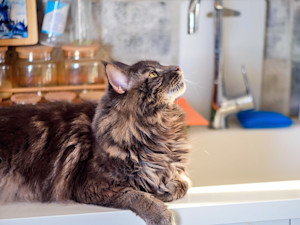How to Discipline a Cat: Why You Actually Shouldn’t
They can be naughty, but punishment is never the answer.

Share Article
In This Article:
Can You Train A Cat Like A Dog? How To Discipline a Cat Without Hurting Them How To Discipline A Cat for Biting How To Train A Cat Not To Jump On Counters
In my opinion, the answer is… you shouldn’t discipline your cat. Any training tactic that causes pain, stress, or fear is simply not OK. Instead of seeing the positive changes you’re hoping for, you’re more likely to see an increase in unwanted behavior due to stress and a lasting negative impact on your relationship. Punishment just isn’t the right approach.
Don’t worry! You don’t need to use this kind of discipline. There are lots of positive-training techniques you can try that will have a much bigger impact on your cat’s behavior and support a loving, healthy relationship.

Can cats be trained like dogs?
Yes! Cats are highly trainable. In fact, many cat training techniques are similar to those used for dogs, though the motivation may be a little different.
Many dogs see pleasing their person as a reward. With cats, it’s more of a barter system. If the reward is valuable enough, they’re happy to participate. If not, you might have to sweeten the pot.
Cats are extremely intelligent. They learn the same way other animals (and people) do — through experience and reward. If you get a brownie every time you smile at someone, you’re more interested in smiling at people. If your cat gets praise every time they use their scratching post instead of the couch, they’re likely to use the scratching post.
Cats also do well with clicker training, a tool often used to train dogs and other animals.
What to do instead of disciplining your cat
Training and behavior modification tactics vary based on the issue you’re trying to address. Here are some general dos and don’ts you can consider:
Avoid punishment
We’ve talked about why punishment is not the way to go. Your cat’s behavior is based on thousands of years of instinctual programming. Punishment is not going to override that instinct. Use positive-training methods instead.
Don’t use physical force
This is a form of punishment. Any physical discipline will have a negative impact.
I know it’s hard, especially when your cat is being aggressive. A cat scratch or bite can trigger us to throw an elbow or kick a leg without even realizing it. We have our own instincts that kick in when we feel pain or potential danger. Do your best to try and manage those reactions. They won’t solve the problem. They’ll just make it worse.
Keep in mind, cats have a strong sense of self-preservation and will defend themselves if they feel they’re in danger. You don’t want to be on the receiving end of a cat fighting for their safety.
Provide alternatives and positive outlets
Punishment doesn’t consider the need your cat is trying to meet with the unwanted behavior. It’s not just about telling them what not to do. It’s about giving them an alternative way to meet that need. There has to be a “yes” option, or they will find their own way to meet those needs.
If your cat is scratching something you don’t want them to scratch, they need a better scratcher option. If they’re getting play-aggressive with you because they’re bored, they need more play and enrichment. If you can figure out the “why,” you can give them a better alternative that works for both of you.
Use positive-reinforcement training techniques.
Yes, yes, yes. Positive reinforcement is the best thing you can do. Reward the behaviors you want to see more of. It works!
If your cat uses the litter box, sits on the stool instead of jumping on the counter, attacks their toy instead of your arm, or anything that makes you say, “Good! That’s what I wanted to see!” reward them. Treats, verbal praise, play, petting, whatever they love, can be used as a reward.
Never scare your cat with loud noises or yelling
The word “scare” is your clue on this one. You want to avoid anything that will add stress or fear. That includes yelling, clapping loudly, stomping, etc.
Again, I know this can be hard. When I hear two cats fighting, for example, my first instinct is to get in there and make noise to startle them apart. But all that does is freak them out more. I must stop and think about what I can do to actually help the situation.
Put away the spray bottle.
Most of us have done it at some point in our lives. I’m guilty. Our cat does something we want to stop, and we grab a water bottle and spray them. This falls into the category of causing stress. We have a really helpful article that dives deeper.
Give your cat space if they’re aggressive.
Most feline aggression is rooted in fear. A scared cat will defend themselves. Play-aggression is another common issue, more often with high-energy cats.
Regardless of the type of aggression, the best thing you can do in the moment is leave the area. If your cat is scared, they need time to decompress and reset. If they’re play aggressive, you want to show them all the fun stops when they get bite-y.
It’s important to work on the triggers for these issues as well (and make sure you’re meeting that need for play in better ways). But, in the moment, just give your cat some space.
Avoid physical punishment for accidents in the house.
We talked about punishment being a bad idea overall. I think it’s helpful to call out house soiling specifically.
That common idea of “rubbing your pet’s nose in it” as a way of showing them why you’re mad is a really bad idea. If your cat is soiling, something is wrong! They either have a medical, emotional, or litter box setup issue. Stress is often a huge trigger.
You can see why that kind of reaction from you is likely to make things worse and won’t help you get to the root of the problem. Instead, take a deep breath and remember that just about anything can be cleaned. Now, you can start working the problem.
Talk with your vet.
Behavior issues can actually be symptoms of medical issues. That’s why it’s vitally important to reach out to your veterinarian when your cat shows sudden, unexplained changes in their normal behavior. Things like soiling, aggression, vocalizing, and even fear can all be triggered by pain and discomfort.
Clicker train your cat.
Clicker training is a great way to work on behavior issues, fear, reinforcing the behaviors you want, and more. Check out our article on how to clicker train your cat.
What to do when your cat bites
Cats can bite for many reasons. Fear or defensive aggression, play aggression, attention-seeking, pain or discomfort, trying to set boundaries, and more. No matter the reason, you can work on the issues in a positive way. We have multiple articles on biting and aggression to help you nail down the type, trigger, and resolution. Here’s a great place to start.
Teaching your cat not to jump on counters
This is such a common issue. From your cat’s perspective, it’s completely reasonable to use all available surfaces in the home. Why not the counter too? There’s also food up there. And that’s where the action is. Everyone hangs out in the kitchen.
From your perspective, it’s gross. Enough said. So … what can you do? You guessed it. Training. Here’s a fantastic article on teaching your cat to stay off the counters.
When to seek expert help
There’s help available when you need it. A feline behavior consultant is a great starting point. That’s what I do. We help identify the needs or triggers behind the unwanted behavior and develop a modification plan to work on it.
Your veterinarian is also a key part of your support team, to rule out or address any possible medical causes for the unwanted behavior.
Bottom line
Discipline, punishment, anything negative that causes stress, fear, or pain is going to do damage. It won’t solve the problem. It will create new problems.
Positive training techniques are the absolute best way to get the results you want and strengthen your relationship.
There’s a reason behind your cat’s unwanted behavior. Figure out what need they’re trying to meet or what triggers the behavior you want to change. Then give them better alternatives.
Use positive reinforcement (rewards) when your cat is doing what you want them to do. This will encourage them to repeat those wanted behaviors.
References
“Feline Behavior Problems: House Soiling.” Cornell University College of Veterinary Medicine, 23 July 2018, www.vet.cornell.edu/departments-centers-and-institutes/cornell-feline-health-center/health-information/feline-health-topics/feline-behavior-problems-house-soilingopens in new tab.
Josling, Catherine, and Claudine Falcis. “Managing Your Kitten’s Rough Play.” UCDavis Veterinary Medicine. https://www.vetmed.ucdavis.edu/sites/g/files/dgvnsk491/files/inline-files/Managing_Your_Kitten_rough_play.pdfopens in new tab.
Kogan, Lori, et al. “Assessment of Clicker Training for Shelter Cats.” Animals, vol. 7, no. 12, 22 Sept. 2017, p. 73, www.mdpi.com/2076-2615/7/10/73, https://doi.org/10.3390/ani7100073opens in new tab.
“Tips for Cat Owners | City of OKC.” Okc.gov, 2025, www.okc.gov/departments/animal-welfare/education-and-resources/tips-for-cat-ownersopens in new tab. Accessed 14 Apr. 2025.

LeeAnna Buis, CFTBS, FFCP
LeeAnna Buis has adored cats her entire life and thought she knew them inside out and sideways. But it wasn’t until she worked with a feline behavior consultant that she fully understood how incredible, complicated, and inspiring they really are. She made a career change, starting the certification process to become a behavior consultant right away. She discovered what unique, fascinating, complex creatures cats are and knew this was what she wanted to do with her life — help others on a similar journey to truly knowing, loving, and appreciating their cats.
LeeAnna earned her certification through Animal Behavior Institute, where she received the certified feline training and behavior specialist (CFTBS) designation.
Related articles
![Woman training kitten at home.]()
How to Train a Kitten
Yes, it’s possible.
Dream of High-Fiving Your Cat? Here’s How to Teach a Cat Tricks
It takes some patience (shocker), but it can be done.
![Cat sitting in a teal litter box]()
How to Train a Cat to Use a Litter Box
If you do nothing else, teach your cat to poop in their litter box (not your shoe).
![Woman playing at home with her kitten.]()
How to Train Your Cat: Tips and Cues for Kittens
Seriously, it’s not as hard as you think.
Should You Train Your Cat to Use the Toilet?
This is not Meet the Parents.
![Big brown cat looking up from the kitchen counter.]()
How Do You Train a Cat to Stay Off Counters?
Excuse me, kitty; that is not your personal balance beam.








